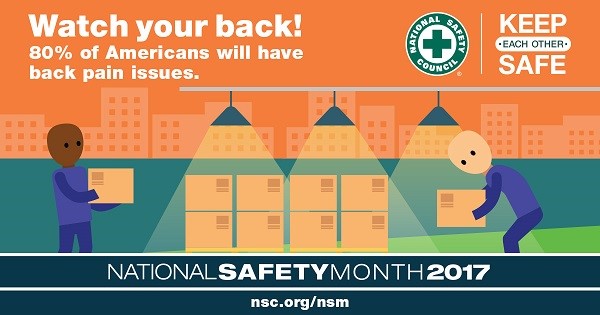National Safety Month Week 4: Don’t Just Sit There (Focusing on Ergonomics)

If you have back pain, you’re not alone. About 80% of the U.S. population will experience back pain issues at some point in their lives, and 31 million will experience low-back pain at any given time. Most of these cases are not caused by serious underlying conditions, but from actions like improper lifting technique.
How to Lift Safely
Prevent strains, dislocations and muscle tears. When lifting, make sure you:
- Stretch and warm up before you perform any lifting
- Keep your back straight and bend your knees – remember to never twist or bend your back
- Are on solid ground with your feet shoulder-width apart
- Keep the box or object close to your body
- Lift with your legs, not your back
- Limit the amount of weight you carry – separate boxes or make two trips instead of carrying more than you can handle
- Ask for help to carry heavy, bulky or large loads
- Keep pathways clear of tripping hazards
National Safety Council (NSC) states that no “sure-fire” rules exist for safe lifting: “Manual materials handling is a very complex combination of moving body segments, changing joint angles, tightening muscles and loading the spinal column.” However, NSC does recommend following several do’s and don’ts pertaining to lifting.
Do:
- Eliminate manual lifting whenever possible to help reduce injuries.
- Stay in good physical shape if lifting items is part of your job.
- Keep materials within easy reach and have handling aids around in case you need them.
- Make sure you have a good grip on any item you attempt to lift. Test the weight and balance of items before moving them. Too heavy? Get a mechanical lifting aid or ask a co-worker for assistance.
- Keep the item you are lifting close to your body. Ensure your feet are close to the load, stand in a stable position with your feet pointed in the direction you’re moving, and lift mostly by straightening your legs.
Don’t:
- Twist your back or bend in a sideways direction.
- Attempt to lift or lower an object if you’re in an awkward position.
- Feel compelled to lift an item that is too heavy – get help instead.
- Lift or lower an object if your arms are extended.
- Continue to lift an item if you realize it’s too heavy.
- Lift above your shoulders or below your knees.
Lifting, carrying, pushing or pulling heavy loads can put workers at risk of serious injury. Practicing these lifting techniques and understanding what to do will help keep your workers healthy and safe.
Read more about safe lifting in the workplace from a previously blog post of ours here.
